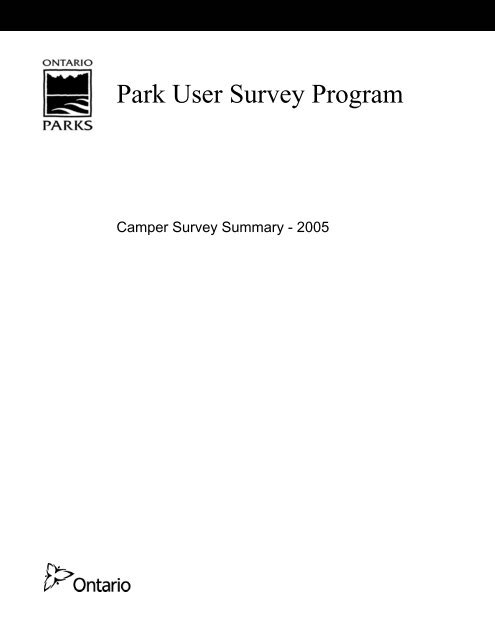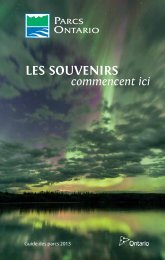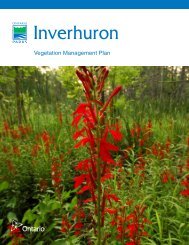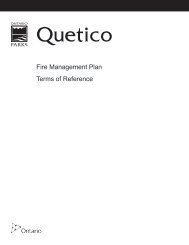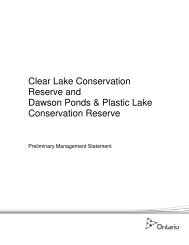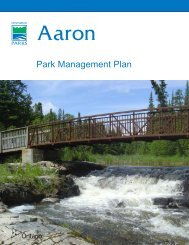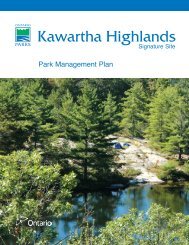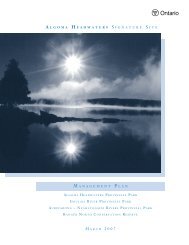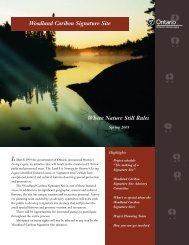Park User Survey Program - Ontario Parks
Park User Survey Program - Ontario Parks
Park User Survey Program - Ontario Parks
Create successful ePaper yourself
Turn your PDF publications into a flip-book with our unique Google optimized e-Paper software.
<strong>Park</strong> <strong>User</strong> <strong>Survey</strong> <strong>Program</strong><br />
Camper <strong>Survey</strong> Summary - 2005
Introduction<br />
The <strong>Park</strong> <strong>User</strong> <strong>Survey</strong> program was initiated in 1974 to provide<br />
information about both day visitors and campers for a variety of<br />
planning, research and operational/management functions. The<br />
program operates on a three-year cycle; eligible parks are included in<br />
the day visitor and camper survey once each cycle.<br />
This iteration of the <strong>Park</strong> <strong>User</strong> <strong>Survey</strong> was intended to survey all<br />
operational parks that were on the online reservation system during the<br />
2005 summer season. Using email addresses collected during the online<br />
campsite reservation system, campers were provided a link and invited<br />
to participate in an online survey. This sampling method was limited to<br />
campers using the online reservation service. Campers using the call<br />
centre reservation system and campers who did not make a reservation<br />
are not included in this survey. There were a total of 93,198 survey<br />
invitations sent out resulting in 35,584 surveys being returned<br />
(approximately 38%). This is over twice as many surveys as the previous<br />
cycle.<br />
71 provincial parks were surveyed across the 6 park administrative<br />
zones.<br />
The survey questionnaire was designed to obtain information regarding<br />
the general demographic characteristics of park campers and to obtain<br />
their evaluation of park services and facilities.<br />
This summary is organized into the following sections: response rates,<br />
characteristics of park campers, extent of park usage, marketing<br />
information, travel data, activity participation, trip related<br />
expenditures, health and well-being, and recommendations to improve<br />
the park.
Summary – 2005 Provincial <strong>Park</strong> Camper <strong>Survey</strong><br />
Based on the results of the 2005 Provincial <strong>Park</strong> Camper <strong>Survey</strong>, the<br />
following summary is provided.<br />
Response Rates<br />
• There were a total of 35,584 responses to the survey from 71<br />
provincial parks. This is the largest response to the <strong>Park</strong> <strong>User</strong><br />
survey.<br />
Characteristics of <strong>Park</strong> Campers<br />
• The two largest camper groups are families (57.9%) and couples<br />
(25.7%). Approximately 13% of camper groups are multiple families<br />
and friends.<br />
• The two largest age groups were adults aged 25-44 (38.6%) and<br />
children aged 0-14 (29.7%). Adults aged 45-64 were the third largest<br />
group, composing 20.2% of campers.<br />
• The mean number of people at each campsite was 3.7. The most<br />
frequently reported group size was four (28%), followed by two<br />
(26%) and three (16%).<br />
• Visitors indicated that the two most common pieces of equipment<br />
used were tents (68.0%) followed by Dining Shelters (30%). Tent<br />
Trailers and Travel Trailers (53.5% combined) were the two primary<br />
types of recreational vehicles used by campers.<br />
• 23% of campers reported that they camped with a dog.<br />
• Over 70% of respondents have graduated from a postsecondary<br />
education.<br />
• 14% of campers had household incomes of less than $50,000.<br />
Slightly more than 27% of campers had a household income of<br />
$50,000 to $69,999.<br />
Extent of <strong>Park</strong> Usage<br />
• Over 90% of respondents reported having camped at a provincial<br />
park before.<br />
• 32% of respondents indicated having camped at non-provincial park<br />
campgrounds in the past year. Visits to non-provincial parks<br />
averaged 2.2 times in the previous year.<br />
• The two most important reasons for choosing the particular park<br />
were “enjoyed previous visit” and “to enjoy nature” at 53.3% and<br />
48.9% respectively.
Marketing Information<br />
• From the camper evaluation of services and facilities; washroom<br />
cleanliness, condition of facilities and value for fee are the most<br />
serious areas that require attention.<br />
• The condition of trails was the only area which scored a higher<br />
satisfaction rating than importance level.<br />
Travel Data<br />
• Slightly over 57% of campers indicated that the trip was their<br />
vacation. Approximately 40% of campers were on a weekend trip.<br />
• The average length of stay was 4.0 nights. The median number of<br />
nights was 3.0 and the most common length of stay was 2.0 nights.<br />
• Most of the visitors indicated having a permanent residence in<br />
central <strong>Ontario</strong> (37.4%).<br />
Activity Participation<br />
• The top five activities were resting/ relaxing, swimming/ wading,<br />
trail hiking (non-guided), viewing/ photographing nature and<br />
picnicking. Campers tend to spend the most time swimming/<br />
wading.<br />
• 16.8% of campers indicated that they had attended an NHE program.<br />
Nearly 25% of campers thought the information was presented in a<br />
professional and informed manner. Only 7% responded “No”.<br />
Approximately 68% responded that they did not know.<br />
Trip Related Expenditures<br />
• Campers spend the most amount of money on food and beverages.<br />
Campers on average spent $147 on food and beverages on the entire<br />
trip $68 of this within 40km of the park.<br />
• The second highest average expenditure was fuel and transportation<br />
at $95 for the entire trip and $31 within 40km.<br />
• Some campers spent a significant amount of money in the previous<br />
year on equipment other campers reported spending little or<br />
nothing. The average expenditure may be greatly influenced by<br />
several campers making major purchases (ie. new RVs).<br />
Health and Well-Being<br />
• All health and well-being categories had a median rating of<br />
“Somewhat Improved” or higher. Mental well-being was rated has<br />
having the greatest improvement (mean 3.9, median 4).<br />
• Over 90% of respondents did not attribute any fewer trips to the<br />
doctor as a result of visiting an <strong>Ontario</strong> <strong>Park</strong>.
Recommendations to Improve <strong>Park</strong> Visit<br />
• Over 90% of respondents reported that they would want to receive<br />
future surveys through email.<br />
• Over 78% of respondents indicated that they had taken actions to<br />
reduce their impact on the environment. Of the responses,<br />
recycling (44%) and picking up garbage (21%) were the most<br />
common.<br />
• Respondents most frequently indicated that keeping/improving the<br />
recycling program (23%) as an action <strong>Ontario</strong> <strong>Park</strong>s can do to reduce<br />
its impact. Education was the second most common response at<br />
13%.<br />
• The gap between the importance and performance rating of the<br />
<strong>Ontario</strong> <strong>Park</strong>s website was 0.5. 67% of users indicated using the site<br />
for a combination of general information searching and making<br />
reservations.<br />
• The top four most frequent suggestions for the <strong>Ontario</strong> <strong>Park</strong>s<br />
website were: 1) photos of campsites/ park (23%), 2) Update/<br />
improve campsite descriptions (11%), 3) NHE <strong>Program</strong>s/ events/<br />
activities/ presentations (10%), 4) Reservation System – See<br />
availability (by date)/ Improve availability of ‘good’ sites (8%).<br />
• The four most common recommendations made to improve the park<br />
and increase visitor satisfaction were: 1) Clean washrooms/showers<br />
regularly/paper & soap/mirror, 2) Add more/Renovate/Update<br />
comfort stations, 3) Better enforcement/ control<br />
rowdies/noise/speed (esp. at night), 4) Great <strong>Park</strong>/no changes.


